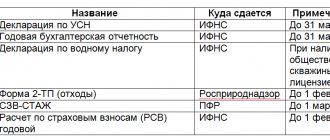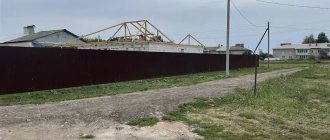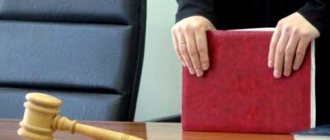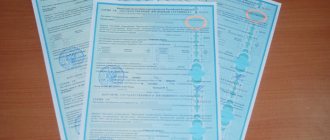The list of property that falls under the term “common house” is indicated directly in the Housing Code of the Russian Federation. Article 36 of this code, in addition, establishes a separate right of ownership of property, recognized as common to the owners of all premises in an apartment building.
Dear readers! Our articles talk about typical ways to resolve legal issues, but each case is unique. If you want to find out how to solve your specific problem, please contact the online consultant form on the right. It's fast and free! Or call us at :
+7 Moscow, Moscow region
+7 St. Petersburg, Leningrad region
8 Federal number (free call for all regions of Russia)!
What does each owner own in apartment buildings?
In residential buildings, in addition to apartments, there may be premises intended for offices, shops, hairdressers, etc. All other property in the house is common, that is, a share in it belongs to each owner . Signs of such property:
- allows you to serve several rooms;
- does not belong by right of ownership to one person;
- is not a hallway, attic, or other part of the apartment.
Common property can be located inside an office or store, for example, cold and hot water supply risers.
An approximate list of property, a share in which belongs to all owners in the house , is called Art. 36 Housing Code of the Russian Federation:
- Auxiliary premises for shared use - landings, attics, elevators, basements.
- Shared premises for social and domestic purposes - fitness rooms, laundries, etc.
- Roofs, engineering equipment.
- The adjacent territory and the objects located on it.
Property is considered joint ownership regardless of how many people actually use it.
Responsibility for damage to OP places
Unfortunately, at all times there are individuals who deliberately cause harm and damage other people’s property: they draw on walls, scratch elevators, litter in hallways, and much more.
There are no effective methods of combating malicious pests in practice. However, the legislation provides for administrative and criminal liability for damage to common shared property.
To identify violators, the most effective method would be to install video cameras in the entrance area of the entrance, in elevators and on staircase landings. If there are video recordings, it is necessary to write a statement to the police, otherwise it turns out to be almost impossible to find the perpetrators.
The punishment for violating the order is a fine of up to 500 rubles. If significant damage is caused in the amount of 2,500 rubles or more as a result of arson, explosion, or harm to human health, criminal liability for hooliganism is possible, in this case the punishment ranges from a fine of up to 40,000 rubles to 5 years in prison.
If the pests are children under 14 years of age, then their parents or legal representatives will compensate for the damage. If a child has reached 14 years of age, he bears the same responsibility as adults.
Who is the owner of the adjacent territory?
The territory around a non-residential building in urban planning legislation is called adjacent (GrK RF, art. 1, clause 37). The term “house area” of a building is used in the housing sector. This is a public area - streets, sidewalks, vacant lots within the municipality.
They are the property of municipalities. The adjacent territory does not belong to the owners of the buildings, but the responsibility for its maintenance is assigned to them by law (Part 9 of Article 55.25 of the Civil Code of the Russian Federation). Owners may delegate such responsibilities to tenants, other legal owners, and management companies.
The obligation of the building owner to carry out improvement of the adjacent territory has been established since June 28, 2021, Federal Law No. 463 of December 29, 2021.
Previously, the courts proceeded from the fact that municipal improvement rules cannot oblige property owners to maintain land plots belonging to municipalities, that is, adjacent territories. Now this practice is not applicable - the obligation is established by federal law.
Who owns the public areas in the building?
Places in a non-residential building that are not used independently and allow the service of more than one room are auxiliary. They provide passage between the main premises, exit outside the building, and operation of utilities. Public areas (PPA) are :
- corridors;
- lobbies;
- internal and fire escapes;
- elevators;
- mines, etc.
The question of ownership of the MOP arises if there are several premises in one building. This situation is typical for office and shopping centers, warehouse areas, etc. The status of MOP is definitely not spelled out anywhere in the law.
However, judicial practice has been formed on this issue (see Resolution of the Plenum of the Supreme Arbitration Court No. 64, dated July 23, 2009). MOP is common property in a building , and the right to it belongs to all owners of the premises. Each of them has a share in the right of common ownership.
In practice, situations are possible when a record is made in the Unified State Register that the MOP in the building belongs to only one of the owners. In this case, it is necessary to apply to the court with a demand for recognition of the right to a share in the common property. The registry entry will be corrected.
What is the status of common property?
In addition to auxiliary premises, the non-residential building has:
- bearing structures;
- roof;
- foundation;
- pipes;
- elevators;
- railings, etc.
Regardless of location, such objects are classified as joint ownership if they are intended to serve more than one premises . The legal status of such property is similar to the status provided for by housing legislation.
The share in the right of common ownership is calculated depending on the area of the premises owned by the owner, and in rare cases - on their volume. When selling or inheriting premises, the share in the right to the common property also passes. The right to such property arises by force of law, it is unconditional and cannot be alienated separately from the main property.
Category classification
Based on the definition of a public place, the following category classification was formed:
- Permanent. Access to these places is open all the time: alleys, streets, boulevards, train stations, squares, squares, embankments, courtyards. The exception is the courtyards of private territories.
- Periodic. These premises are intended for recreation and serving the population at specific hours. Among them are markets, medical, health and educational institutions, entertainment, cultural, sports structures, recreation areas, public transport, trading establishments, passenger compartments (at night), train cars for passengers (in addition to vestibules), a dining car and a toilet.
Contents order
The owners of the premises have the right to establish the regime for the use of the common property of the building, as well as the adjacent territory, at a meeting. You should act in accordance with the Housing Code of the Russian Federation (Article 44–) and the Civil Code of the Russian Federation (Chapter 9.1).
The meeting of co-owners can be held in person, in absentia or in a mixed form and must be recorded. At least half of all participants must be present, and the decision is made by a simple majority of votes.
The list of activities for maintaining the adjacent territory must comply with municipal landscaping rules. They indicate the rules and procedure for the participation in such events of persons authorized to be responsible for the operation of the building (GrK RF, art. 55.25, part 9).
Relevant offenses
From the total number of offenses that are committed by definition in public places, it is advisable to single out street offenses, in other words, those committed in socially developed areas. We are talking about streets, boulevards, squares, embankments, alleys, bridges, unfenced courtyards (with the exception of private courtyards). In addition, violations can be implemented in forested areas, residential areas, within urban settlements, public gardens, recreation areas, on beaches, stadiums, and markets during operation.
Owner's responsibilities
Civil legislation provides that the owner’s responsibilities for the maintenance of common property are financial in nature (Civil Code of the Russian Federation, Art. 249). However, by agreement among themselves, co-owners can also provide for a different format of participation - for example, cleaning the territory, participating in cleanup days.
- MOP must be maintained properly, that is, in compliance with SanPiNs, GOSTs, in a safe condition.
- Stairs, elevators, corridors must allow free use of the building and its parts.
- Engineering communications and metering devices must be in a state of readiness and operability.
- The external appearance of the building is consistent with the architectural design.
The rules for maintaining common property in an apartment building are determined by the Government of the Russian Federation (Resolution No. 491 of August 13, 2006).
Is the owner obligated to pay for common household needs?
The law places the burden of bearing the costs of maintaining and preserving the property on the owner of non-residential premises. The Housing Code of the Russian Federation details that the monthly fee includes :
- fee for maintaining the premises;
- contributions for major repairs (you can find out who should pay for major repairs of non-residential premises here).
Payment for services for maintaining the premises in proper condition includes payment for the maintenance of common property in an apartment building.
You cannot transfer to another person your right to part of the common property of the apartment building, as well as the responsibilities for its maintenance separately from the right to the main premises.
Final part
So, we have fully considered the category of public territory. As it turned out, the current law does not define this term in any way. Nevertheless, some regulations define the characteristics that characterize such an ambiguous concept. Therefore, most lawyers believe that this definition requires serious improvements. It is also necessary to create the clearest possible interpretation. The fact is that it is for violations in public areas that people are brought to administrative responsibility.
In a general sense, a public place should be understood as an area where people can suddenly appear at any time of the day. We are talking, for example, about a bus stop, a playground, a park, educational, medical, entertainment institutions, exhibition complexes, public transport, as well as other government structures and those areas where the population is served. Since in practice, law enforcement officers quite often charge individuals for drinking alcohol, smoking and behaving indecently in crowded places, it would be absolutely useful to include a certain formulation of the concept in question in the Code of Administrative Offenses.
It is worth remembering that among the signs of a publicly accessible territory, the main ones are the following: the unhindered appearance of people, in other words, they can come to these places absolutely suddenly; holding persons administratively liable even for minor hooligan acts, as well as smoking and drinking alcohol. Therefore, a public territory, the definition of which is not enshrined in the current legislation in Russia, should not be called someone’s private dacha, house, garage, building for only one extremely simple reason: all this is the personal property of citizens, and it is illegal to enter there without the invitation of the owners.
Should the owner transfer funds for one-room parking and an elevator?
The obligation to participate financially in the maintenance of property belonging to all owners of premises in the building is unconditional and does not depend on what kind of premises is owned - an apartment or an office. It also does not depend on whether such property is actually used.
Owners of beauty salons on the ground floors must pay for the maintenance of the elevator and roof, and apartment owners must pay for the maintenance of corridors on the ground floors intended for office space. In 2021, this position was supported by the Supreme Court of the Russian Federation (Plenum Resolution No. 22 of June 27, 2021).
Accrual of ODN in MKD
The government has determined the procedure for calculating and paying fees for the maintenance of premises in section 6 of the Rules for the provision of utility services. They were approved by Resolution No. 354 of May 6, 2011. General house needs (GDN) include :
- Maintenance of electrical wiring, gas and water pipes located inside the house.
- They may also include organizational costs for working with debtors, taking meter readings, and working with payments.
- Expenses for public housing also include payment for utilities consumed for general needs - lighting, heating of common areas, etc. (read about what is included in utilities for non-residential premises in an apartment building, what are the features of their payment, and from In this article you will learn about how owners can pay for electricity according to tariffs).
The payment scheme depends on the management method in the house . With the most common method - choosing a management company - the payment for the ODN is included in the payment for the maintenance of common property. At the same time, the payment form provides a detailed calculation of the costs of one-way service.
Consumption of communal resources for general house needs and the surrounding area should not exceed the standards established by each subject of the Russian Federation.
Excessive consumption according to ODN must be paid by the management company.
The amount of payment for the use of each utility resource is determined after readings are taken from the common meter, taking into account the area per owner.
Features of communal housing
Living in the same apartment with neighbors who are complete strangers can hardly be comfortable. After all, each person has his own habits and a certain daily routine.
Life in a communal apartment means constant quarrels over noise, various little things, and also over public places. It is difficult even for adults to instill the idea that they just need to respect each other and abide by certain agreements.
How to draw up an agreement for the maintenance of non-residential premises?
To fulfill obligations to maintain his property, the owner of a commercial premises should enter into an agreement with a service organization . It could be:
- A separate agreement for the maintenance, maintenance and repair of non-residential premises (we talked in detail about the maintenance of non-residential premises in an apartment building here).
- The management agreement for an apartment building, which is concluded with the management company and each owner - Art. 162 of the Housing Code of the Russian Federation (read about what operational management of non-residential buildings and premises is, as well as the nuances of concluding a contract, here).
The agreement must be drawn up in writing and signed by the owner of the premises and the organization providing maintenance services.
It should define the following essential points:
- who are the parties to the agreement;
- what relates to the common property of the house (building);
- what are the organization’s responsibilities for maintaining the property - a list of works, services, provided utility resources;
- What are the owner’s responsibilities for making payments - the payment procedure, payment deadlines.
Our specialists have prepared information for you about the rules for the use and ownership of non-residential real estate. In particular, read about how to:
- connect to the Internet while complying with the law;
- correctly draw up an agreement with the cleaner;
- act in case of flooding.
General understanding of the term
Since the enforcement of articles of the Code of Administrative Offenses regarding drinking alcoholic beverages and petty hooliganism occurs quite often, it is advisable to formulate a more precise definition of a public place. The importance of detailed wording (or rather, its absence) becomes absolutely clear if we take into account that a mandatory condition for the use of Articles 20.1 and 20.20 of the Code of Administrative Offenses is considered to be the commission of violations specifically in public areas. Next, we will consider the essential characteristics and features of a publicly accessible site.
The definition of a public place implies a lack of regard for personal property. For example, a country house or someone’s apartment cannot be recognized as such. A similar conclusion can be made about entertainment and shopping complexes, because these areas have an owner, and they themselves are considered private property. The definition of a public place under the Code of Administrative Offenses allows for the appearance of different people in it, both in groups and individually, as a rule, at any time of the day.










